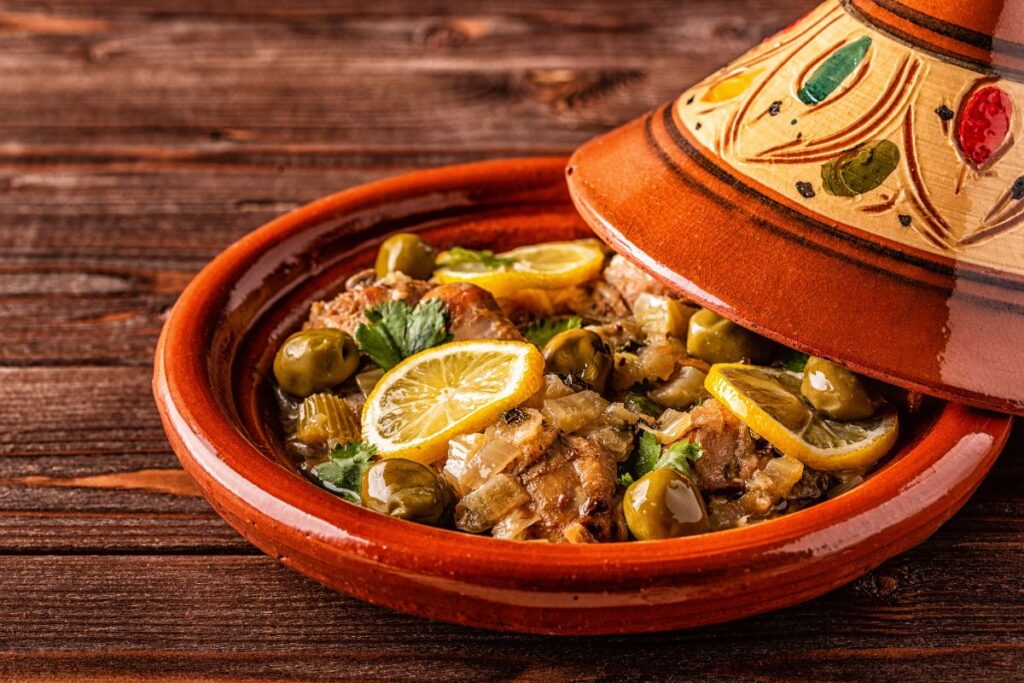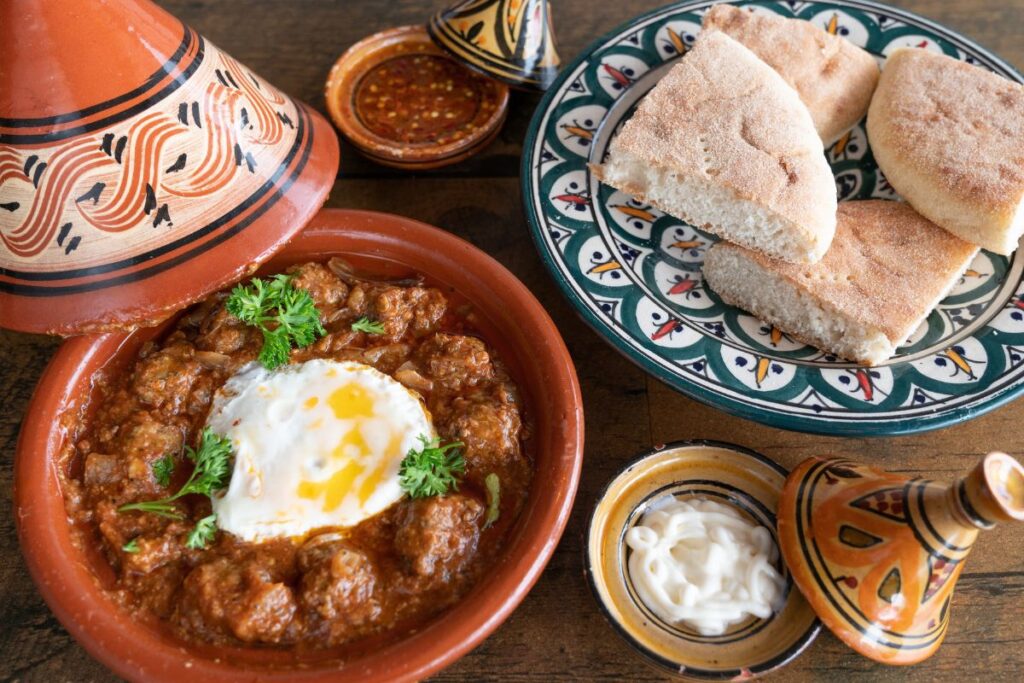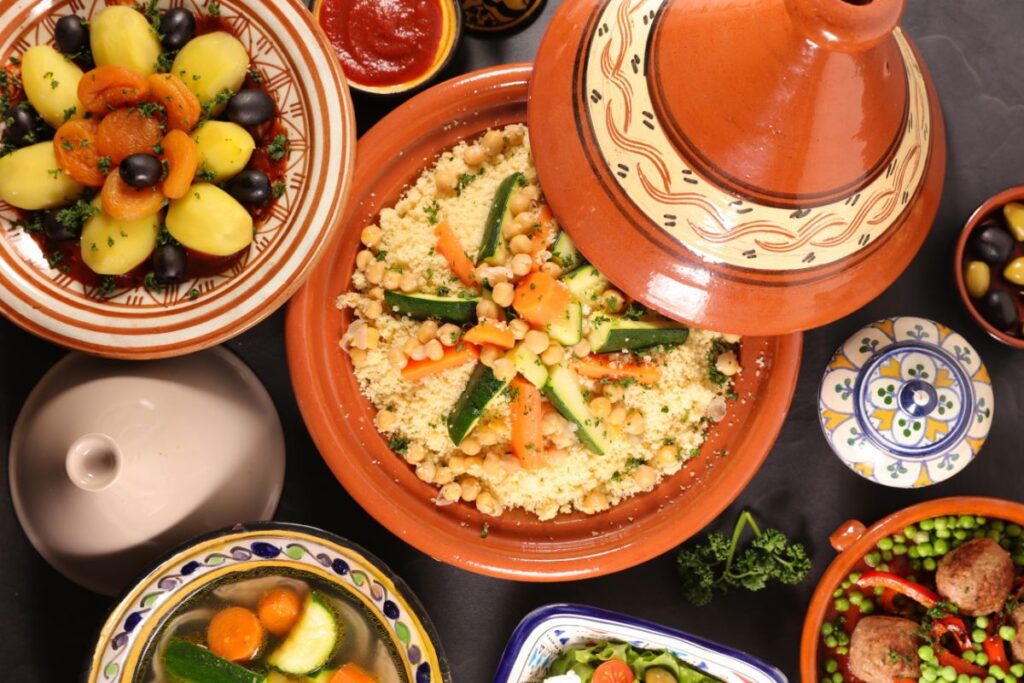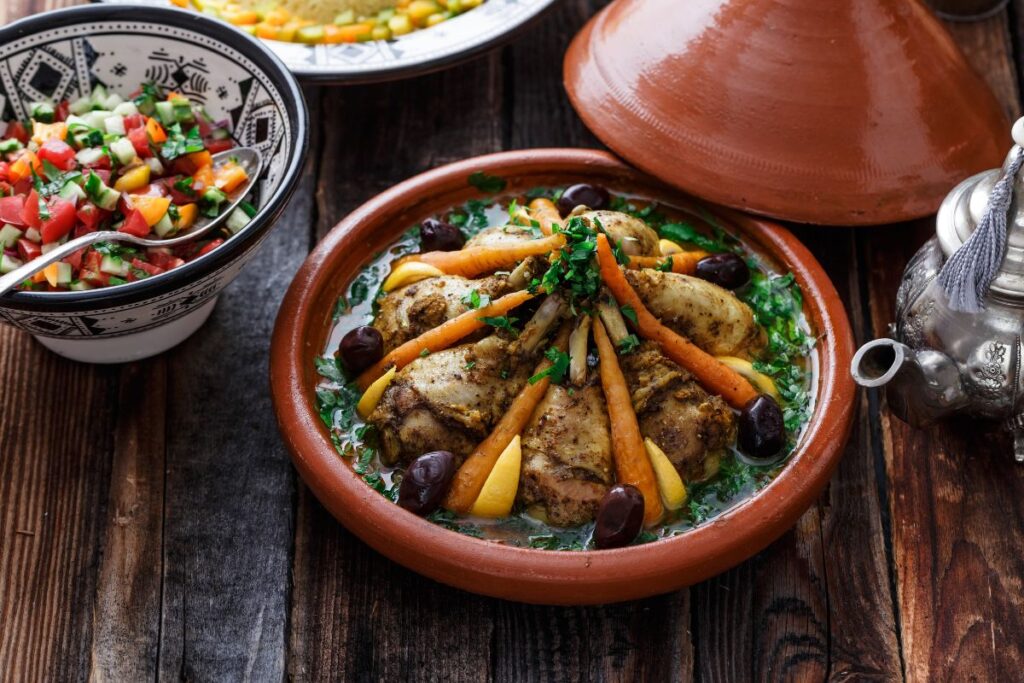Moroccan Tagine: Moroccan traditional food is spicy, salty, sweet, and savory, with a sauce as thick as syrup. It is a dish of tender meat, fish or vegetables stewed to perfection in a thick, oily sauce, with the addition of fruit, herbs, spices, often honey and chili. Classic Tagine is lamb stew with dried fruits, chicken with pickled lemons and green olives, duck with dates and honey, and fish cooked with fresh tomatoes, lemon and coriander.
Moroccan tagine

Moroccan Tagine: Moroccan traditional food is a dish that takes its name, precisely, from the dish. Or rather: from the container in which it is cooked and served, a small earthenware casserole with a conical chimney-shaped lid.
Tagine origin
Today we can enjoy the Moroccan Tagine: Moroccan traditional food thanks to the Berbers, natives of North Africa and Egypt. Although Tagine is a Berber dish, other people who lived at different times in Morocco have influenced its taste and preparation. Among them the Arabs, the descendants of the Moors who emigrated from Andalusia, the Sephardic Jews and the French colonizers.
By the way, Tagine is also made in Tunisia, but in a very different way. In our words, Tunisian Tagine is more like an Italian frittata or a casserole.
Tagine recipes
Therefore, to speak of Moroccan Tagine, Moroccan traditional food, is a real wild card: an infinite number of recipes can be cooked in this original contraption! All the recipes have in common that, as with so many other Moroccan dishes, they must be cooked over low heat, first as a stir-fry in the casserole dish and, after adding the seasoned water, as a slow-cooked stew.
The embedded meanings of the Moroccan Tagine

The Tagine is not only decorative, it has a lot of meaning. It is the perfect pot for stewing. This is because a special condensation of steam occurs thanks to the domed lid. The Tagine is cooked for a long time and over low heat. The steam, impregnated with spices, rises, condenses on the walls of the dome and flows back over the ingredients. Thus, there is a constant circulation of moisture inside the Tagine. Thanks to this process, everything cooked in the Tagine is unusually tender and juicy, enveloped by aromatic steam.
What is special about a Tagine?
And what is the purpose of the conical lid? Well, for two purposes at the same time: on the one hand, to keep the food warm and, on the other hand, to prevent it from drying out. In the latter case, this is achieved because it prevents them from losing moisture and condenses on the inside walls of the lid and is precipitated back into the casserole.
The most popular Moroccan Tagines

As we said, there is an infinity of Moroccan Tagines. And we are not only talking about Tagines according to the city or the region but also according to each home and each restaurant, each one can give it its special touch or even create a recipe from scratch!
Of course, the ones you will probably find more often during your trip to Morocco are the following, as we indicate on our Gastronomy page:
Chicken Tagine: this is the most popular. For example, the one that combines this meat with lemon and olives.
Lamb Tagine: cooking it with boiled eggs, almonds, and dates is very common.
Beef Tagine: with apple and raisins, it achieves an interesting mix of flavors, including salty and sweet tastes.
Fish Tagine: made with fresh fish, vegetables, and spices, cooked in a Tagine pot. It’s a light and healthy option that can be enjoyed on its own or with couscous or bread.
Tuna Tagine: with onion, tomato and other vegetables.
Sardine Tagine: with red bell pepper, green bell pepper, tomato and potato.
Vegetarian Tagines: as can be deduced from the way it is prepared, Moroccan Tagine lends itself perfectly to vegetarian recipes. Among the most common ingredients are legumes (especially chickpeas), nuts (almonds), vegetables (tomatoes, zucchini, carrots, etc.), fruits (dates, apples)… and, of course, a good dose of spices and herbs.
The best brands of Tagine

Although to cook Moroccan Tagine at home, especially on the glass-ceramic hob, it is still preferable to buy a French-made Tagine. Our stores abound with Tagines from well-known, high-quality brands such as Emile Henry and Staub, Le Creuset. These brands will offer you heat-resistant ceramic or enameled cast iron. Cast iron is good because you can fry the meat before stewing it. In the north, in cities such as Tangier and Casablanca, where the Spanish and French influence on local cuisine is evident, meat is roasted beforehand.
In Fez and Marrakech, Tagines are usually cooked by combining all the ingredients and adding a little water and oil at the end of cooking. You should try having a cup of Moroccan tea with the tagine to experience the cultural vibe fully.
As you can see, Moroccan Tagine is a whole world. Therefore, the best thing to do is… try several during your trip so that you can compare and evaluate. We will help you to choose a restaurant if you wish!
What is Moroccan tagine?
Moroccan tagine is a traditional dish made of slow-cooked meat, vegetables, and spices, named after the conical clay pot used to cook it.
What are the main ingredients in Moroccan tagine?
The main ingredients in Moroccan tajine include meat (usually lamb or chicken), vegetables (such as onions, tomatoes, and potatoes), and a blend of spices (including cinnamon, cumin, ginger, and saffron).
How is Moroccan tagine traditionally cooked?
Moroccan tagine is traditionally cooked in a clay pot with a cone-shaped lid, placed on top of hot coals or a stove. The slow-cooking process allows the flavors to blend and the meat to become tender.
What are some popular variations of Moroccan tajine?
Some popular variations include chicken with preserved lemons and olives, lamb with prunes and almonds, and beef with eggplant and tomatoes.
Is it a spicy dish?
Moroccan tagine can be spicy, depending on the blend of spices used in the recipe. However, it is not always spicy, and the level of spiciness can be adjusted to taste.
Can Moroccan tagine be made with vegetarian or vegan ingredients?
Instead of meat, it can be made with vegetarian or vegan ingredients, such as chickpeas, lentils, or tofu.
What are some popular side dishes to serve with a Moroccan tagine?
Some popular side dishes to serve with Moroccan tagine include couscous, bread, salad, and harissa.
Is Moroccan tagine a healthy dish?
It can be a healthy dish, as it contains a variety of vegetables and lean protein. However, the amount of oil or salt used in the recipe can affect its nutritional value.
Where can I try authentic Moroccan tagine?
You can try authentic it in many restaurants and cafes throughout Morocco and other countries with a significant Moroccan population.
Can I make Moroccan tagine at home?
Yes, you can make it at home with a clay pot or a regular pot and a stove. Many recipes are available online and in cookbooks for different variations of Moroccan tagine.

